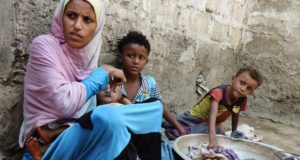Humanitarian catastrophe looms in Yemen
With more than three million people displaced and almost twenty million in need of protection or material assistance, the civil war in Yemen has become the world’s largest humanitarian crisis.
Since 2015, of the 3.3 million people who have been forced to flee their homes to seek safety, two million remain displaced and nearly 1.3 million have returned to the governorates they originated from.
With no end in sight for the conflict, displacement is set to continue to increase and 18.8 million people now need humanitarian or protection assistance.
The United Nations says that years of poverty, underdevelopment, environmental decline, intermittent conflict, and weak rule of law – including widespread violations of human rights – have contributed to over five years of crisis.
 The breakdown of basic services and institutions, such as hospitals, widespread poverty, environmental decline and collapse of the agricultural sector have all further compounded the situation, it says.
The breakdown of basic services and institutions, such as hospitals, widespread poverty, environmental decline and collapse of the agricultural sector have all further compounded the situation, it says.
The conflict and its economic consequences are also driving a food crisis. More than 17 million people are currently food insecure, of whom 6.8 million require immediate food assistance.
“The crisis in Yemen is not only characterised by conflict but also by natural disaster-induced large-scale displacement and complex external migration flows and mobility patterns,” said the Deputy Director General of the UN Migration Agency IOM Laura Thompson.
“We cannot close our eyes to the mobility dimensions of this crisis. IOM has, since the escalation of violence in 2015, scaled up its response in Yemen to assist displaced populations and host communities,” Ms Thompson said.
“In 2017, IOM is committed to doing more and will continue to deliver life-saving humanitarian aid, with a specific focus on the immediate and longer-term needs of migrants, internally displaced persons (IDPs) and the conflict and natural disaster affected communities in Yemen,” she said.
Yemen has a complex migratory status, as a country of origin, transit, and destination.
Regular migration flows between the Horn of Africa and Yemen have surged, with 10,000 migrants entering the country each month, as a result of conflicts and the complex political and economic dynamics of the region.
The number of migrants has overwhelmed available resources. In addition to those staying in Yemen, many migrants transit under alarming conditions through war-torn Yemen to Saudi Arabia in search of work, and are often victims of smuggling rings and other criminal networks.
This week the United Nations through IOM and the governments of Switzerland and Sweden hosted a pledging event in Geneva to raise support for the crisis in Yemen.
The co-hosts and participants in the event aim to avert a humanitarian catastrophe by raising the US$2.1 billion needed to deliver crucial food, nutrition, health and other lifesaving assistance in Yemen.
The IOM is seeking a further US$76.3 million to fund migrant assistance and protection, child protection, shelter support, water and sanitation activities, health and mental health support, food assistance, displacement tracking, efforts to combat gender-based violence and victim support and early recovery activities.
“We therefore commit and call on partners to unite behind a holistic and robust humanitarian response; for governments to support and commit to political dialogue towards ending this crisis, and for the parties to the conflict to facilitate immediate, timely and unimpeded humanitarian access,” Ms Thompson said.
“More needs to be done before the situation in Yemen reaches a point of no return,” she said.
Laurie Nowell
AMES Australia Senior Journalist












